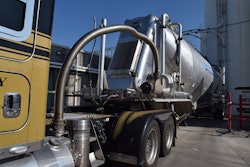When purchasing a truck, don’t take the first financing option you’re offered. You can often negotiate loan rates just as you can haggle over the price of a truck or the rate on a load.
Interest rates vary because of many factors, and finance managers have some leeway when setting a rate for you.
Some finance companies offer lending options:
Variable rates. Most truck loans have a fixed interest rate, which means that you pay the same rate throughout the term of the loan. Sometimes you can get a variable rate. This usually is a good deal if prime rates hold steady or drop, but if rates go up too much for too long, as they have in recent years, you might end up paying more than you would have under a fixed-rate loan.
More principal up front. With this option, your monthly interest charges and payments decline over time. Having lower payments in the latter part of the loan helps in two ways: It gives you more cash for truck maintenance as the truck ages, and it allows you to save for your next down payment as the time to trade approaches.
Skip-payment plan. Designed for truckers with seasonal freight, this plan allows you to miss a payment or two during slow times. You make the arrangements at the time of purchase. A variation is an extension of the first payment, say to 45 days, something many lenders are willing to do if your credit is strong.

Programs for buyers low on cash or credit. Some owner-operators without the cash for a big down payment or access to favorable loans have seen success buying in carrier sales programs for used fleet trucks. Unlike many lease-purchases in such programs, buyers do not have to be affiliated with the carrier.
A shorter loan period. This means higher payments but big savings in interest. If you’re used to 72-month loans -- generally the owner-operator’s favorite -- try to make a 48- or 36-month deal work.
Qualifying for a good rate. Big contributing factors to interest rates are how much you put down, the type of truck you buy, your credit score and your loan-to-truck value ratio. For owner-operators with good credit and a sizable down payment, many local banks can offer rates below 10%. Those with credit issues could see rates higher than credit card rates.
Put more money down. More than one small fleet owner has suggested a “sweet spot” for equipment debt -- at well less than 50% of the truck’s value at time of purchase, essentially. Some owner-operators swear by this, too, buying only when cash reserves for new purchases are such that they only need to finance less than 50% of the purchase price, keeping monthly payments low. Such a strategy allowed more than one owner to hang on when the COVID-19 pandemic threw freight markets into disarray, upsetting the incoming revenue/cost balance.
Though some owner-operators may find it difficult to get financing, lenders today are more willing to work with used truck buyers than in the tougher years of the 2009 recession. The upturn in freight that followed brought many lenders back into the business.
While the price of trucks continued to get higher, the ability to make an economic return with that investment was there. At the same time, high-mileage trucks make lenders more hesitant, and they’ll also want decent down payments, often around 20%.
First-time buyers could see interest rates of 18% to 20% or more, and first-time buyers and buyers with credit problems should be wary of service charges that could add $1,000 or more to monthly payments.
Meeting debt obligations and saving for a 25% down payment should open the door for a first-time buyer’s financing. Those buyers also do well if they have three to four accident-free years in trucking.
[Related: It's a deal: Perfect timing yields $50K saved on a new truck]
The bottom-line impact of interest rates, good credit
With interest rates on a steady, quick rise through much of 2022-’23 and into 2024, it’s important to know how much that can impact a loan, along with the beneficial impact of bringing a good credit score.
Say an owner-operator with relatively good credit financed $100,000 on a five-year term (common for many truck loans) in pre-2022 times at 6% interest.
Total loan amount: $100,000
Monthly payment: $1,933
Interest paid at full term: $15,997
That same owner buying a year later, or another with a less-than-stellar credit score, could expect the loan to come with far higher interest rates attached. The ultimate impact is quite costly. An extra 4.25% in interest, as an example, boosts costs for the same loan by much more than 4.25% over the entire term:
Total loan amount: $100,000
Monthly payment: $2,137 (or +10.6% over the more favorable loan terms)
Interest paid at full term: $28,222 (or +76.4%)
It’s important when making a purchasing decision to not get too emotionally attached to a deal before it’s done. If you’re engaged in talks with a dealer on a truck, and they attempt to pull back a somewhat favorable offer for something more unfavorable for your business, don’t be afraid to walk away. Results might surprise you.
[Related: Do owner-operators need to worry about credit scores?]
Read next: Used trucks: How to evaluate a rig to protect long-term value prospects










